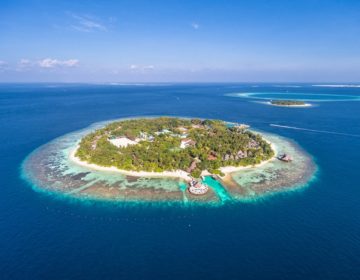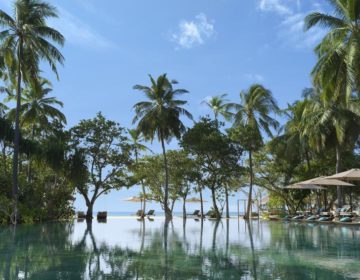There are many channels on the eastern side of North Nilandhe Atoll, most with reasonably shallow entrances around 20 to 25 meters. They have a number of reefs rising from the bottom to the surface allowing safe, controlled diving across the channel when the current is favorable. The shallow channels quickly give way to a deeper interior with depths around 30 to 35 meters. In these channels, many big fish like mantas, barracudas, eagle rays, Napoleon, white-tip and grey sharks, as well as whale sharks in the northeast monsoon, can be seen. Most of the diving is in the north-eastern side of the atoll although regular trips to the south are made by Filitheyo Resort, the only resort in the atoll. It attracts a great deal of attention, with many resort divers focusing on the north side of the channel, as well as the more spectacular Filitheyo Thila and Dolphin corner, on the southern side. This atoll offers spectacular and varied diving with a sense of isolation unparalleled anywhere in the Maldives.
 Filitheyo Resort is the only resort in the atoll.
Filitheyo Resort is the only resort in the atoll.
Two Brothers
This is a channel dive on the north side of Fieeali with two thilas that attract a wide range of fish. The largest thila lies in the middle of the channel and rises to five meters from the channel floor at between 22 and 28 meters. The second and smaller thila is closer to Fieeali and rises to 10 meters. A couple of caves on the inside of the large thila are worth a visit. Usually, there are stingrays on the sand and often eagle rays and sharks swimming across the channel entrance. A steep drop-off at the entrance plunges from 30 meters to around 45 meters.
 Usually, there are eagle rays swimming across the channel entrance.
Usually, there are eagle rays swimming across the channel entrance.
Jumping Jack
This is an exceptional dive that has an underwater ridge across the entrance of the broad channel at around 20 meters. On this ridge are seven thilas with top depths ranging from eight to 12 meters. There are many options for diving this channel, depending on the conditions. With a stronger current, divers can spend the entire dive on the southern outside corner where there are caves at around 30 meters and spend the remaining dive around the first and largest thila with a sand channel at 26 meters. In the right conditions, divers can cross the channel and vary their dive to cross inside the channel at any one of the eight sandy passages. Rounding the corners of these thilas is always a good option to catch large fish, like grouper, by surprise, as well as stingrays and turtles. There are caves at different depth offering delightful interludes to this underwater excursion.
 Rounding the corners of these thilas is always a good option to catch large fish, like grouper (above), by surprise, as well as stingrays and turtles.
Rounding the corners of these thilas is always a good option to catch large fish, like grouper (above), by surprise, as well as stingrays and turtles.
Diving Hints
If drift diving across the channel, follow the outside line of thilas keeping your depth above 20 meters. Rise to the top of the thilas towards the end of the dive and finish if possible close to the main reef. Its easy to become separated from your group if winding between the thilas, so always carry a safety parachute in case you have to surface in the middle of the channel.
Lighthouse Channel
This is a fascinating exploratory dive with nine thilas that allow many different diving options. These include deep-water drop-offs with caves, differently shaped thilas at alternate depths, sand channels of varying length, direction and width, and drift diving with long bottom times. Divers usually start on the south side when conditions are favorable, take a look at the outside drop-off for sharks, eagle rays and big fish and make their way north across the channel, keeping their dive relatively shallow. If the current is flowing strongly in or out of the channel, as it often does, then some protection can be gained on the lee side of the thilas, allowing opportunities in the many sand offshoots to see stingrays and less obvious fish species, such as scorpion fish and sand gobies, as well as invertebrates such as sea cucumbers, soft corals and shrimps.

Diving Hints
If drift diving across the channel, don’t go too deep or fight the current. Relax and use air sparingly and keep moving across the channel.
Seven Stingrays
This is a channel dive on the south side of Dhiguvaru Falhu, the reef with a shallow lagoon on which seaplanes land. This wide channel has a thila in the middle, and when conditions are favorable, it is possible to explore across the channel to the thila. There are good caves on the southwest side at 25 to 30 meters and a ridge running parallel with the outside of the atoll. Many fish, grey reef sharks, eagle rays and plenty of sponges can be seen. There are also a number of pipe cleaner black corals, and if you take a close look at these bushes, a small commensal black coral crab can usually be seen. There are excellent coral beds on the western edge of the thila around 15 meters, before sloping down to the sand. Stingrays can always be found on this sandy slope, and their presence has given this site its name.
 Black coral crab can usually be seen on the pipe cleaner black corals.
Black coral crab can usually be seen on the pipe cleaner black corals.
Kings Corner
A good beginners dive with protection from strong currents. It is also ideal for photographers looking at large schools of fish that include blue-striped snapper, humpback snapper, fusiliers and gold-spot emperors. Angelfish are also prevalent, and the occasional sling-jaw wrasse can be seen. If you are lucky, these fish can be seen at cleaner stations with their jaws extended. There are six or more coral bombies on the sandy bottom between 12 and 25 meters that are the main area of interest here. Keep a look out for turtles and stingrays on the sand.
 The occasional sling-jaw wrasse with its extended jaw can be seen.
The occasional sling-jaw wrasse with its extended jaw can be seen.
Filitheyo Thandu – PROTECTED MARINE AREA
Filitheyo Thandu is a two-kilometer-wide channel with three main dives: Filitheyo Outside, Filitheyo Thila, Dolphin Corner. Filitheyo Thandu is a shallow U-shaped reef with a top varying from 10 meters to 20 meters. This reef encloses a sand valley where stingrays are often seen along with large schools of fish. Around the thila are numerous caves, mostly around 20 meters and deeper. Two smaller reefs outcrops with a top depth of 10 meters and caves on the outside at around 20 meters are located near the outside reef. They are spectacular sites that attract sharks, Napoleon fish, and eagle rays. More caves are located on the outside drop-off below 30 meters.
Dive this spectacular reef and stay at the Filitheyo Resort. Click here to book.
 Filitheyo Thandu is a two-kilometer-wide channel with three main dives.
Filitheyo Thandu is a two-kilometer-wide channel with three main dives.
Filitheyo Outside
This is a reef that protrudes steadily down into the channel along a narrow ridge 20 meters wide to a depth of over 30 meters. It features batfish, Napoleon, caves, and coral outcrops, sweetlips and snapper. Dolphin Corner is a similar finger of reef protruding into the channel from the southern side. Divers are advised to start on the steep outside reef and drift to the corner where the reef slope flattens out. Notice the corals, blue-finger sponges, hydroids and feather stars. In strong current, hold on to dead coral and view white-tip reef sharks, Napoleon, eagle rays, and schools of fusilier, and snapper. With an incoming current, a good option is to drift over to the protection of the lee side of the reef. There are also two huge mushrooms corals on the corner, one at 15 meters and the other at 10 meters. Here many fish gather including Moorish idols, blue triggerfish and powder blue surgeon.
 Mushrooms corals.
Mushrooms corals.
Barracuda Kandu
This is a 500-meter wide channel with a depth of around 20 meters across the entrance. The northern side is the most popular diving section with large coral outcrops inside the channel at 20 meters and a shallower section at five meters on the corner. Large schools of barracuda are seen here as well as eagle rays.
Biledhdhoo Kandu
This is a one-kilometer-wide channel with four separate thilas in the middle with depths ranging between eight and 14 meters. Narrow sandy gutters with a depth of 17 to 20 meters separate each thila. The southern side of the channel has a deeper channel of over 25 meters. Stingrays are regularly seen on the sand bottom and schools of sweetlips make a colorful sight.
 Stingrays are regularly seen on the sand bottom.
Stingrays are regularly seen on the sand bottom.
(Source: Dive Maldives: A Guide to the Maldives Archipelago. Tim Godfrey. Atoll Editions, 2015)



